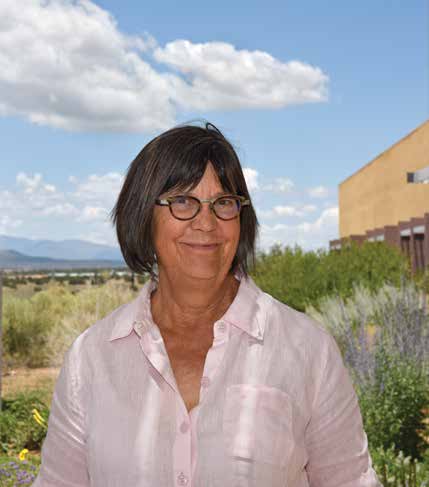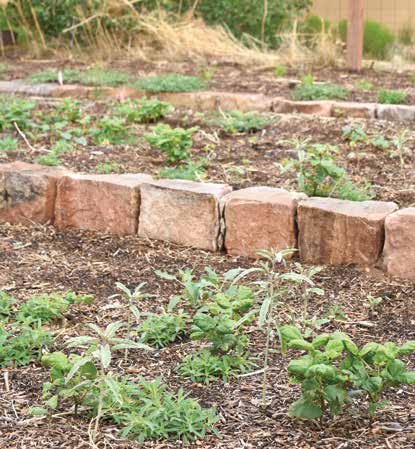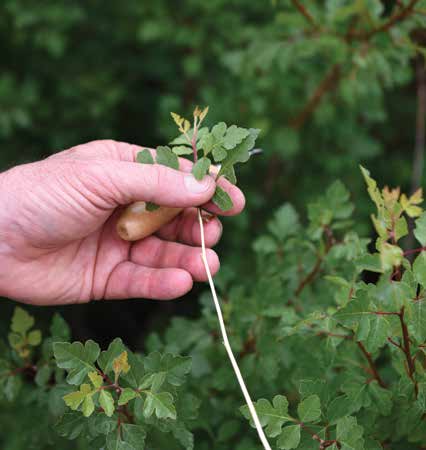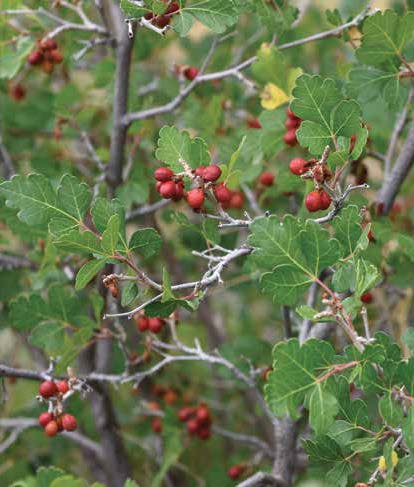Office of Archaeological Studies

Fall 2021 Member News
Garden of Time: Learning from the Landscape
It’s a hot and blustery summer day outside the Center for New Mexico Archaeology, where Office of Archaeological Studies ethnobotanist and educator Mollie Toll is showing off recent developments at the Walk Through Time Garden.
“I would like to encourage people to embrace the idea that landscaping is not just something to look at,” says Toll. “It’s something to learn from.”
As sheets of dust blow in from the Jemez Mountains, it’s easy to slip into the reality of ancient New Mexicans who stubbornly coaxed life out of the dry, rocky desert. The garden is slowly taking shape in chronological order around the vast archaeology complex, providing visitors with a glimpse of plant use at every phase of New Mexico history.
Toll walks through the Hunter/Gatherer section, currently the most developed portion of the project. Close to 40 different trees and plants of historic and cultural significance surround the building, including various types of yucca, three-leaf sumac, cottonwood and cholla. Each is identified by small signs installed last winter with the common and scientific names of each plant and its uses.
Toll says plants for the garden have been obtained in a variety of ways, including salvage from construction sites where they would otherwise be destroyed. Over the years, Lynette Etsitty (Diné), an archaeologist with the Office of Archaeological Studies, carefully tended several of the sumac plants to produce shoots for use in traditional coiled basketry demonstrations and workshops.
“It’s interesting when you talk to kids about how people used plants and animals in the past,” says Toll. “One of the things they’re really interested in is how they got their clothes. A whole lot of that is yucca, because it can be processed to be a soft and fine fiber for textiles.”
The Hunter/Gatherer section (which also features Apache plume, purslane and prickly pear) gives way to Early Farmers (sunflower, squash, beans), and then to Pueblo Farmers, where the team will grow beeweed, cotton and gourds. Toll points to the proposed site for the Spanish Colonial Garden Orchard as the most ambitious. It will require the planting of plum, apple and cherry trees, as well as the construction of an acequia irrigation system. Other sections will include medicinal, dye and pollinator plants.
Looking over the relatively small progress on the elaborate garden plan, Toll is practical about the project’s needs, which will require both private funding and volunteers to fulfill.
“You wouldn’t trust a library without a librarian, and a garden can’t survive without a gardener,” she says.
Toll estimates the proposed grounds to be nearly 15,000 square feet, noting that most grants are designed for much smaller projects.
“It would be fabulous to have some time devoted by one person who is watching over the whole project and coordinating volunteers, giving at least five hours a week,” she says.
For now, the project is taking baby steps, with plans for plant-based demonstrations on-site at the center during International Archaeology Day on Saturday, October 16.
The public’s enjoyment of the Walk Through Time Garden is “woven into our mission,” Toll says, which is aimed at reminding New Mexicans and visitors that the plants around them have hidden values and important roles in the history of New Mexico.
“The garden being so big in such a dramatic setting, I think we’re able to give people a sense of these broad sweeps of time,” Toll continues. “From here, you can really get a sense of what the New Mexico landscape is and was.”
“We’re able to give people a sense of these broad sweeps of time.”
To support the Office of Archaeological Studies, contact Lauren Paige at Lauren@museumfoundation.org or 505.982.2282.





Connect